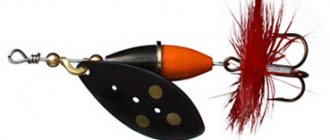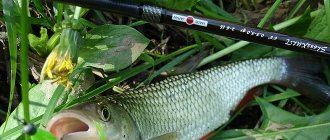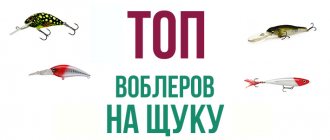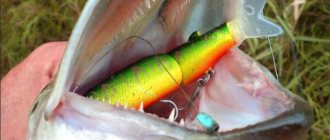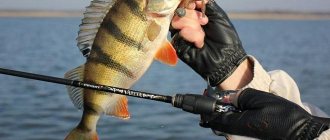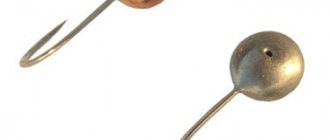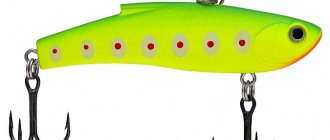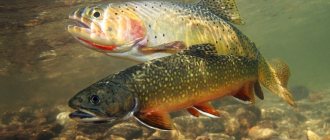Brown trout? Difficulties in classification
Swedish naturalist Carl Linnaeus identified brown trout and trout as three distinct species:
- Migratory brown trout (Latin name Salmo trutta): feeds in the estuarine areas of the seas, and enters adjacent rivers to spawn. It is often called lake salmon, although the name “salmon” itself is collective and does not correspond to any of the fish species included in the family of the same name.
- Lake trout (Salmo trutta morpha lacustris), some researchers consider it a subspecies of brown trout due to its similar coloration. The fish feeds in large lakes, but prefers to reproduce in the running water of rivers and streams flowing into the reservoir.
- Brook trout (Salmo trutta morpha fario), also known as pied trout or common trout: not prone to migration, prefers mountain streams or cold rivers with fast currents. The color depends on the color of the soil and varies from dark brown to yellow.
Note! The body of brook trout is not silver in color. This is its main difference from brown trout and lake trout.
In modern classification, the migratory brown trout is considered to be the ancestor of all species of brown trout and trout. At the same time, it is difficult to obtain a clear answer to the question of how trout differs from brown trout: the future fish is shaped by its habitat.
It has been established that trout can be obtained from trout eggs. And vice versa. In the natural environment, these fish often spawn together. After some time, trout fry that have rolled into the sea return to their native river like brown trout. If for some reason the brown trout babies do not go to sea, they will continue the trout genus at sexual maturity.
This genetic plasticity makes species delineation difficult.
Most modern scientists consider brown trout and trout to be two forms of the same species. The migratory form is classified as common trout. The freshwater sedentary form of brown trout is called trout. At the same time, pay attention to the size: if lake trout reaches a length of a meter or more, it is also considered to be brown trout. Specimens caught at sea are classified as brown trout, even if their size does not exceed 30 cm (for example, Baltic brown trout rarely grows more than 50 cm).
Know your opponent by sight
The color and body shape of the fish varies in different bodies of water. In large lakes, a silvery tint predominates throughout the body. River species have a silvery color mainly on the sides, with a wide light brown stripe along the back. There are fish with a greenish back and a silver belly.
Juveniles are much lighter than adults and are often mistaken for trout. You can distinguish brown trout by the so-called parr spots: large dark stripes on the sides, usually 9–10 of them. Juvenile trout do not have them.
Trout have the following specific characteristics:
- mouth slanted down;
- hook on the lower jaw (only in large fish);
- powerful tail;
- small adipose fin.
Where to look
The chance of catching a wary fish increases with the ability to “read the water” and knowledge of the places where it prefers to stand. In this case, it is enough to fish only promising areas:
Which wobbler is best for catching pike
- long riffles, rocky ridges: brown trout overcome obstacles by making long stops. There is also a chance to catch grayling on fast currents;
- the so-called “tongues” in front of the rapids, in places where the river bed widens, where the energy of the flow weakens;
- when a strong current enters calm water, in the shadow of large boulders or rubble from fallen trees: here the fish rests before the next throw upstream. A prerequisite is deep water or a passage that allows you to quickly get to depth.
Fish stay in stagnant or slow-moving water for a short time. She prefers a fast stream with a high concentration of oxygen.
Brown trout can be found on rocky rifts
Geographically, the Kola Peninsula is considered a win-win “brown trout” option. Catching rivers: Ponoy, Srednyaya, Olenka, Varzuga, Pulonga, Vaenga. The following lakes can be distinguished: Domashnee, Tyuva, Verkhnevaengskoye, Lyavozero, Yanozero, Kolozero. The Pirenga River, which flows into Lake Imandra, is famous for its trophy specimens.
The north of Karelia is no less popular among trout hunters. The palm belongs to the large deep-water lake Pyaosepo, where you can catch fish weighing 10–12 kg. The following lakes are rich in trout: Onega, Ladoga, Nyukozero, Topozero (an accumulation of grayling is also noted here), Segozero. From the rivers: Shuya (Belomorskaya), Pongoma, Suma, Tunguda, Pistajoki and many others.
Where does brown trout live?
There are not many trophy winners in the ranks of our brother, so let’s land and look at “fish K” from the point of view of a professional spinner. The use of the adjective “professional” in the context of any sentence sounds somewhat bragging, but here this word will come in handy. And that's why.
Let me make a reservation right away - trolling is not considered in this material and is equated to fishing with a net, dynamite, spear, bleach and other methods that run counter to the philosophy of modern spinning.
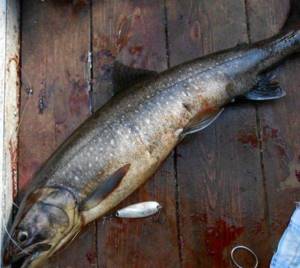
By the time the author of the material was puzzled by fish K, he already had experience working with brook trout and grayling, so no problems were seen in this event. But in vain. Over the course of 4 seasons, two weeks each, I couldn’t even hold on to this fish.
Although, catching only brown trout was not the goal. It’s just that in promising places there has always been an emphasis in this direction. For example, the bait was changed, a dozen more casts were made, and so on.
A kind soul, a local huntsman who was rumored to have been born with a silver spoon in his mouth, said that for a certain reward he would reveal the secret of the miracle fish. The reward found its owner immediately, and the suffering fisherman received short but practical advice - “catch a pike and you’ll catch a brown trout.”
“Excellent,” I thought as I approached the foam-white threshold, “a so-so place to catch pike.” Indeed, at first glance, fishing in a roaring stream seems impossible, if only because the fish simply cannot survive in this terrible whirlpool.
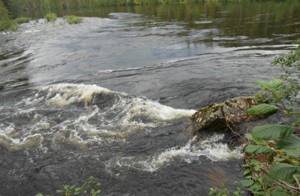
So, let's break stereotype number one. The choppy waters are full of fish. We see a surface turbulent current, but the fish are below, behind the rocks, on the border of the streams. The water is saturated with oxygen, the streams carry food, carry away weakened fry, which is still necessary for the fish. And it’s easier for salmon to hide from pike here.
As for Olanga, almost all local species are caught from the stream, with the exception of whitefish and ide, but pike, perch, grayling, brook trout and brown trout quite well bite on spoons in the stream.
Quality gear is the key to success
The first period of active fishing for brown trout and trout occurs in the second half of May - early June, the second begins at the end of August and lasts until the first winter frosts. October is especially promising for fishing: fish rush to any moving bait. The most favorable time for fishing is at dawn or an hour before sunset.
You can catch in different ways. The fish is omnivorous and is equally likely to bite on bait, vegetable baits, wobblers, spoons, and fly fishing flies. The most popular in hunting trout are:
- spinning;
- float rod;
- fly fishing;
- trolling.
All gear must be balanced: for a light-class fishing rod, select a reel of the same level and soft fishing line of small diameter.
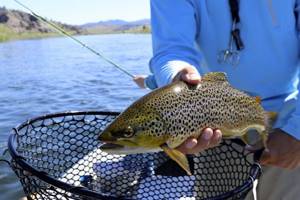
Fishing gear must be of high quality. An active and strong fish exhibits fierce resistance when fished.
How not to get on the list of poachers
The Fisheries and Water Resources Conservation Act prohibits fishing in all bodies of water during spawning season. The spawning period is determined by regional authorities.
There are strict regulations on the permitted minimum size of brown trout caught. On the Kola Peninsula it is 40 cm, in Karelia - 60 cm for fish caught in lakes Pyaozero, Tikshozero and Topozero, 40 cm for inhabitants of other reservoirs.
According to the Fishing Rules for the Northern Fishery Basin of the Russian Federation for the Republic of Karelia, fishing is generally prohibited in some areas. It also stipulates the terms and conditions of recreational fishing in various reservoirs of the republic, which may change. More detailed information can be obtained from the Department of State Control, Supervision and Fishery Protection for the Republic of Karelia (phone).
The fishing rules for the Northern Fishery Basin of the Russian Federation regulate salmon fishing on the Kola Peninsula. You can find out about fishing conditions in a specific period from the Barents-White Sea territorial department of Rosrybolovstvo (8 (8152) 79-81-00).
A representative of the salmon family is distinguished not only by its strength, but also by its cunning. The brown trout deigns to attack the bait exclusively within specific areas of the reservoir, the boundaries of which it itself sets. The key to success is methodical fishing of all promising places.
The well-known joke “the main thing is to hit the fish on the head with a spoon” in relation to brown trout sounds convincing. Casting accuracy is another component of fishing success. Finally, the most important thing in hunting trout is high-quality, properly balanced gear.
Source: intellifishing.ru
Wobblers for trout by trolling
Spinning fishing
This method is one of the most reliable and interesting. Experienced spinning anglers for fishing for brown trout and lake trout advise stocking up on a rod about 3 m long with a test of 5–30 g. Hard whips are undesirable, since with weak shock absorption the brown trout will inevitably tear the fishing line.
A spinning reel with a spool capacity of 1000–2000 is suitable. It is important that it has a reliable friction brake. Whether to wind a braided cord or monofilament line onto the spool is a matter of choice for the angler. Serious craftsmen usually take 2 spools with them: one with braid (breaking force 3–4 kg), the other with fishing line 0.2–0.25 mm.
A leash is a necessary piece of equipment. You can take elastic metal or modern fluorocarbon. The latter is characterized by increased strength and invisibility in the water column.
It is important to decide on bait. The following have proven themselves to be excellent in fishing for brown trout (as well as grayling, which often coexists with trout):
- wobblers 2.5–7 cm in bright colors (yellow, orange, bright green). Among fishermen, the most catchy wobblers for trout are considered to be silver ones with a yellow or pink belly;
- rotating spoons No. 1, 2 (for fishing on riffles and fast currents), “threes” are suitable at depths and calm water;
- small oscillating spoons that imitate the behavior of fry.
Usually fishermen have a variety of baits in stock, and the choice is made on the spot experimentally.
The art of fishing
It is best to catch this fish in cloudy weather in the morning or evening. The situation should be calm, no one should scare her. Due to its fastidiousness, it requires a special bait.
Depending on how the fishing is going, you need to do the following:
- If fishing is dynamic, you need to leave the wiring.
- When fishing is calm, you should provoke the fish to attack by creating a sudden movement.
The important point is hooking. To ensure its reliability, you need to raise the rod so that the line is taut. You need to remember that the greater the angler’s distance from the prey, the more force required to hook.
Conclusion
It must be said that brown trout are fast and strong trout, it is difficult to know what they will bite on. But all the efforts to catch it are justified, because its meat is tender and has beneficial properties.
Float rod
For those who like to “sit with a fishing rod,” we advise you to take the telescopic version, which has good sensitivity.
The unbridled nature of brown trout places certain demands on the rod:
- length not less than 5 meters;
- it is desirable that it be made of carbon fiber (even better, with the addition of composite materials, for example, boron-containing fibers). This rod is very light, has high flexibility, which allows you to make sharp casts over fairly long distances;
- varnished rather than painted (gives additional strength).
If you plan to hunt for a trophy specimen, a braid of nickel threads will not be superfluous. The cost of such fishing rods is high, but there is a little secret here: serious manufacturers, releasing the latest models to the market, reduce the price of collections from previous years.
The rod is equipped with a spinning reel, monofilament fishing line 0.2–0.3 mm, a large hook No. 6–8 and a sliding float. Suitable baits include a worm, caddis fly larvae, and live bait (it’s good if it comes from the same body of water).
Best synthetic baits: nymphs, wet flies or fancy flies. They are also used when fly fishing for brown trout and trout. With this method, the easiest way is to let the artificial bait go with the flow (“drift” wiring). Additional movement is given to the fly by twitching the rod tip.
The bite of brown trout is very sharp. The float instantly goes to the side or under the water. It is important to make the cut quickly. Otherwise, the brown trout will spit out the hook.
How to fish
As mentioned above, brown trout are serious fighters. Once taken from the stream, it reacts instantly and with great aggression. During the first minute of the fight there are 5-6 candles, a stand on the tail or one jump that is crazy in height with somersaults and head shaking.
Keeping such fish is not easy. If you suddenly rush and start fussing, the fish will leave. Be sure to pay attention to setting the clutch. Make it a habit to tune it every time you go out on the water.
The fishing line requires constant attention at a distance of 1 m from the bait. This area rubs against stones and often fails without proper attention.
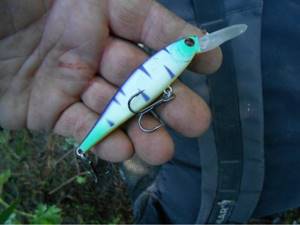
Now we have come to the culmination of fishing - the direct removal of fish from the water. A landing net is rarely used in fishing, even if it is available, it can be used in one case out of ten.
Usually the fish is dragged ashore with a fishing rod, or by grabbing it by the braid. The maneuver is unaesthetic, fraught with injury to the fish, but reliable. True, you need to grab the braided line right at the very shore for a winning throw. This procedure applies only to those who decide to eat fish as food.
For those who only want a photo, we can advise you to tire your opponent properly, wait until the jerking stops, and only then carefully drag him onto the stones.
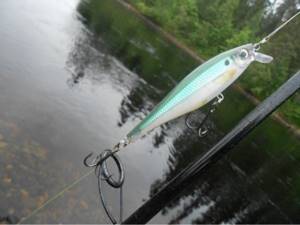
In addition to oscillating spoons, wobblers sometimes work well for brown trout, but their use depends on the specific situation. For example, a hole was discovered near the shore with a small reverse “draft”.
The likelihood that there will be fish there is high and you want to catch them as carefully as possible. An oscillator is not suitable here, since its speed will be fast. This is where wobblers come to the rescue with all the variety of movements - uniform, with stops, twitching and so on.
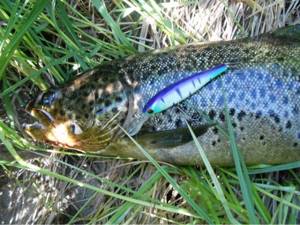
When talking about fishing for brown trout, we cannot fail to mention streamers, which sometimes work more efficiently than spinning baits.
However, speaking specifically about Olang, classical fly fishing here is difficult due to the overgrown banks. The spots suitable for fly fishing can be easily counted on one hand.
Therefore, the Karelian bombard is in use here; it is cast using a spinning rod. Essentially, this is an ordinary olive with a long leash after it and a streamer. This type of gear is used to catch not only salmon, but also pike and perch. However, this tackle deserves a separate article.
Trolling
On large bodies of water, it is interesting to hunt for trout from a motor boat using the trolling method (or a track, if the boat is rowing). You need to look for fish along the edges of the shallows, in holes, and in the water areas of the islands.
Trolling places special demands on gear:
- highly sensitive short (1.9–2.4 m) spinning rods with powerful guides and a long handle. There are models equipped with a device for resting on the belt. They are convenient for fishing. The test is usually selected for a specific body of water: the stronger the current, the higher the upper limit. If you plan to fish with deep wobblers, test values of 100–150 are desirable; for shallow rivers 30 is enough. A spinning rod with a test value of 80 is considered optimal;
- multiplier reels: unlike spinning reels, they can withstand increased axle load;
- monofilament with a diameter of 0.35–0.4 mm (there are special trolling models marked troll) for the active movement of the bait.
Effective baits include an oscillating spinner and a wobbler with frequent oscillations, no more than 10 cm in length. Typically, several spinning rods are used when trolling, which allows you to experiment with baits and increases the likelihood of a decent catch.
Wobblers for trout trolling
Wobblers for trolling. Our American colleague’s next article is devoted to salmon trolling, and we chose it not by chance. This method of fishing is becoming increasingly widespread in Russia, especially in the north-west, where there are huge lakes inhabited by salmon, brown trout, and trout. We hope that the results of Doug Strange's many years of observation of the behavior of trout in lakes and reservoirs, and he has been hunting for them for more than 40 years.
Advice on techniques for finding and catching it will be useful to those of our readers who decide to try their hand at lake trolling. Trout seems to me to be one of the most predictable fish found in lakes and reservoirs. This is especially clearly confirmed in spring and early summer, when the habitat of predators is limited by temperature limits, and forage fish remain at fairly shallow depths.
To catch it, there is a trolling method that works effectively in different regions of the country, especially where there are several species of salmon. The system is so simple that it does not require detailed explanation and much time for installation. I prefer to troll on a small boat with a tiller motor. You can fish just as successfully from a large boat, especially if it is equipped with a bow trolling electric motor with remote control.
This makes it easy to control it while sitting in the stern while fishing. The average trolling speed is about 3.5 km/h, although at times you can speed up. The bait should be cast as quickly as possible, but without disturbing their game, in order to cover a large area of the reservoir. Over the past 25 years I have experimented with almost every type of lure.
Trolling area

- A 1, B and D - open water in a large bay or opposite the mouth of a river flowing into the lake, where, starting in spring, a lot of forage fish and trout can accumulate. Trout can be found anywhere in open water, but are most likely concentrated along drop-offs six meters or more deep, especially at the edges, in areas such as B, near a submerged island, or in a pocket such as D.
- S-1 - trout sometimes move to shallower water, to underwater saddles, for example, in an area where a deep “pocket” turns into a saddle. In addition to trolling, this place is very good for long-distance fishing from an anchored boat.
- S-2 - a fairly shallow area isolated from the depths can be feeding for a long time.
- A-2 is a deep area in open water where trout can be found moving around in search of food. It is usually too large for trolling at random, especially in the spring. It is best to troll along a steep edge off the shoreline, like Point E. Sometimes feeding trout will concentrate in an area like E-1. Deep “pocket” D is a key area for trolling with gliders, working all year round.
Without a doubt, oscillating and rotating spoons can be considered to work well, but most often they are not as effective as small wobblers, for example, Count Down Minnow No. 3 (Rapala). Spoons work just as well as wobblers when fishing from the shore because they can be cast over a longer distance. However, when trolling, I sometimes had to observe situations, especially in the autumn, when spoons worked clearly better than wobblers.
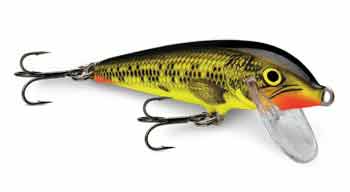
Count Down Minnow (Rapala)
When fishing in very large bodies of water, there is often a desire to try larger baits - to selectively select large fish. But in most cases, the use of large bait does not lead to a bite from trophy fish, since the most common trout food items correspond to the size of very small wobblers. The Count Down No 3 is probably the best lure for most fishing conditions.
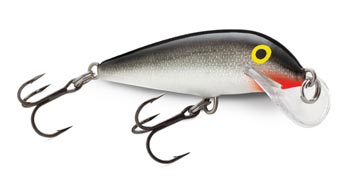
Count Down (Rapala)
Because it goes a little deeper than other floating minnow-shaped wobblers. A floating single or multiple crankbait helps when trout move into shallower water, toward the edges of vegetation. But this happens very rarely in most reservoirs. Sometimes it is worth taking a slightly larger Count Down No. 6, which is 6.35 cm long, Count Down No. 3 - 2.5 cm shorter.
One of the reasons the other Huskyjerk wobbler performs well is that this lure comes in “glass” versions. The “glass” effect is complemented by subtle color shades along the contour and entire surface of the transparent body of the bait, enhanced by a silver insert inside the wobbler. Three of the seven models in “glass” colors brought consistent success, and I never had to adjust the lures after purchase.
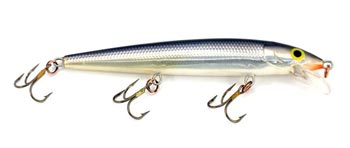
Huskyjerk
These are Glass-Minnow wobblers (“glass fry”), which perfectly imitate smelt and juvenile whitefish, as well as juvenile herring; Glass-Perch, which has a hint of green and much more of a silver tint than other perch colors (and a subtle orange tint to the belly), and Glass-Blue-Minnow. it has, as you can guess, a subtle blue tint on the back, silver from the inner body and a faint chartreuse tint on the belly.
Glass Minnow
Glass-Perch
Glass-Blue-Minnow
Whenever possible (depending on where I'm fishing and the amount of gear I can throw out), I always start fishing with at least one Count Down and one Husky Jerk. The Count Down outperforms the Husky Jerk in most waters, but the Husky catches bigger fish. What is the structure of a spinning rod and everything connected with it, you will learn from this post.
I am not a fan of installing a winding ring on the nose loop of a wobbler, so I always remove it. I tie a loop knot or put a small fastener on the fishing line to secure the bait. Regardless of the size of the intended trophy, I use fishing lines such as, for example, colorless monofilament Trilene XT (Berkley) with a breaking load of 6 pounds (2.72 kg).
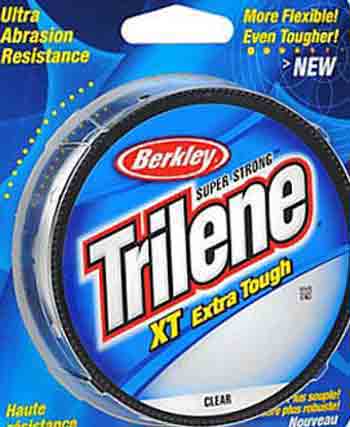
Trilene XT (Berkley)
The four-pound (1.81 kg) is too light to mount my trolling system. And, of course, there is no need to take a more powerful fishing line, except for situations when you have to fish near vegetation and “strong” places. This past season I experimented with 6 pound fluorocarbon, but did not find any difference with monofilament nylon line.
Although I have accumulated quite a lot of positive experience using fluorocarbon in order to see its advantage in some trolling situations. About 30 cm in front of the bait, a small swivel is placed on the main line to minimize its twisting, which disrupts the movement of the wobbler when it is released far from the boat. When twisted, the line becomes less stretchable.
Rods and mini-gliders
There are two main types of rods that work well, depending on how you use your trolling program. A longer 9-foot, fairly soft rod is used to work with a mini-glider. This rod is easy to control when the bait needs to be moved a little further from the side of the boat.
Trolling along is steep. coastal edge
To cast the bait on a long line behind the stern of the boat, take a rod 6 to 7 feet long, with a slow or medium-slow action. Often a trout can take it when the line is spread 45 m behind the stern of the boat. On other days, a spread of 60 m is required, and sometimes 75 m. To begin with, I throw the bait about 20 m behind the stern, then pause to make sure that the bait is moving correctly. But I do this after first checking the game of baits at the beginning of the day next to the side of the boat. Only after this I arrange the prisons in their places.
As soon as the boat starts moving, the trout move away from it. Some of the fish gradually return, filtering into the fishing zone by the time the baits pass through it. During certain periods of the summer season, trout can be quite high in the water and then difficult to see on the fish finder screen. But you can always control the progress of the baits. Gliders on a fishing line expand the fishing area, allowing bait to be placed on the sides of the boat.
Production mini-gliders work flawlessly and often prove to be effective trout fishing tools. The size of a half-liter mug, the Church Tackle TX-6 Magnum is about one-third the size of a regular glider: smaller profile means less clutter. By incorporating these small gliders into your trolling system, you will see a noticeable increase in overall bites, especially on calm days.
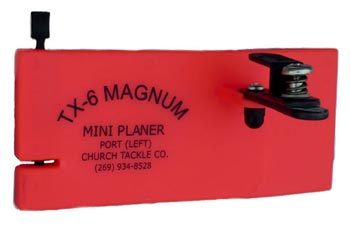
Glider Church Tackle TX-6 Magnum
Trout usually cannot pull the line out of the glider clip, so you have to land the fish with the glider on the line. Most often I start the bait run with the line spread 30m behind the glider and let it go about 20m off the side. The best system for trout is one or two long lines just astern: a glider line on the port side and another one from the right.
Where are the trout?
In spring, in lakes and reservoirs, active trout usually feed in the upper layer of water, from 3 to 5 m. Rainbow trout loves water with a temperature of about +12°C. Immediately after the ice melts and then for a month, fish can be caught with a slight depth of bait. Even when the temperature of the upper layer of water exceeds +12°C, trout continue to feed at the surface, and then move deeper, only occasionally rising for fish fry or to grab an insect that has fallen into the water. Only when a thermocline is clearly established and the upper layer of water to a depth of 6-12 m entirely becomes warmer than +12°C does the trout begin to spend the bulk of its time in the thermocline or under it.
Where to look for trout
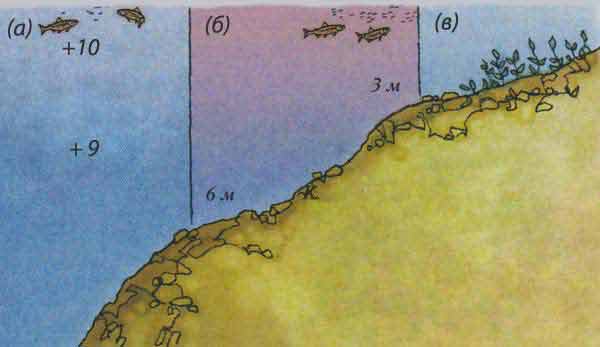
- (a) - trout pushes the food fish to the surface in open water
- (b) is a key area where forage fish accumulate from open water and do not want to go further aground. It is easiest for trout to be pushed to the surface, and this becomes their main feeding area.
- (c) - too small
But even then, predators often move away from the thermocline to feed near the surface during the short period of sunset and twilight. Of course, trout sometimes enter shallow bays or rise to underwater humps and sand spits. Often, significant groups of fish hang above the depths in large bays opposite the mouths of tributaries or in the main water area of lakes and reservoirs.
They use the surface of the water as a boundary towards which they push small fish. They drive the fry to the shores with a steep underwater edge, especially in the first weeks after the ice melts. Trout, in fact, is not a schooling fish, but forms groups for hunting over large areas. Look for schools of forage fish and trout will be close by. There is nothing unusual in finding a whole gang of predators along a 200-400 meter section of a steep coastal slope, especially with a moderate wind blowing towards the shore.
Trout, which has gained strength by the fall, strongly resists, making wild jumps when fishing. Overall this is a simple fishing activity suitable for any angler looking for a great day on the water. This fish has excellent gastronomic qualities. It has pink, delicious meat that can be lightly smoked and cooled, fried on the grill, in the oven or, in extreme cases, in a frying pan. Happy hunting!
By Doug Strange
